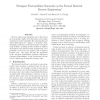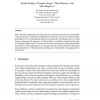1329 search results - page 82 / 266 » Semantics of Architectural Connectors |
WCRE
1995
IEEE
14 years 1 months ago
1995
IEEE
Reverse engineering of program code is the process of constructing a higher level abstraction of an implementation in order to facilitate the understanding of a system that may be...
INFSOF
2002
13 years 9 months ago
2002
While software methodology encourages the use of libraries and advocates architectures of layered libraries, in practice the composition of libraries is not always seamless and th...
PERCOM
2010
ACM
13 years 8 months ago
2010
ACM
—Today, RFID is used to identify a wide range of work pieces or individual products for tracking their movements through the logistics chain. For future purposes the idea of stor...
HT
2011
ACM
13 years 1 months ago
2011
ACM
One of the key motivating factors for information providers to use personalisation is to maximise the benefit to the user in accessing their content. However, traditionally such s...
SAC
2005
ACM
14 years 3 months ago
2005
ACM
Recommender Systems (RS) suggests to users items they will like based on their past opinions. Collaborative Filtering (CF) is the most used technique to assess user similarity bet...


